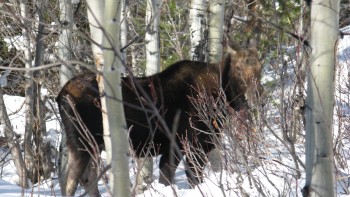
Transition to winter continues. November brings more snow to the Tetons moving animals to winter habitats. Lakes freeze for early season skating. Cold, frigid temperatures drive movements as species prepare for short days, snowy weather, and the season of dormancy.
Winter is the time for wildlife viewing near the town of Jackson. Town is located in the southern part of Jackson Hole. The “hole” is 45 miles long and 10-15 miles wide. It is a valley nestled in the magnificent Rocky Mountains.
The Tetons, being a young mountain range, are jagged peaks and appear as sentinels protecting the valley. The majestic Snake River flows through the center to join the Columbia River and onto the Pacific Ocean. The southern part of the hole offers great winter habitat.
97% of Jackson Hole is protected. The town of Jackson, south in the valley, is part of the 3% where many people live. It is ideal wintering grounds for the animals since it is lower in elevation, has less snow accumulation, and protection from the elements. The buttes near town, the East and West Gros Ventre Buttes, shelter the town and support our local mule deer population. South and east facing slopes have more exposed vegetation so the deer can reach forage.
Most elk in the valley move to feed grounds. With over 20 feeding areas, there are lots of options. The largest being the National Elk Refuge outside of town.It is 25,000 acres and one quarter of the historical habitat. We live on the other 75%. Today, feeding animals is controversial since Chronic Wasting, a viral disease, could easily be spread through a concentrated herd. Hard to find balance since we live where the elk historically wintered.
The Bison herd discovered feed on the elk refuge about 15 years ago so they now come for food. They are large and feisty. They push the elk off the alfalfa pellets. Because they disrupt the feeding, bison are fed on the back of the refuge to keep the elk and bison apart.
The elk refuge was established in 1912 so elk come near town and other species follow. Coyote, wolves, eagles, ravens, mountain lions and hawks might be seen. The Miller Butte is also in the refuge and winters Big Horn Sheep. Wow!
Moose often follow waterways and prefer willow. The Snake River parallels the Teton Village Road, Highway 390. Moose can be found along this road. They also like bitterbrush which grows in the valley. You might see them near the airport to greet you as you arrive.
Due to the location of town, wildlife winter quite close to humans. Be observant and careful when driving. Many areas near town close December 1 to protect winter range. Winter is a season of scarcity for an herbivore as they wait for spring and new growth.
Life is rich in the Greater Yellowstone Ecosystem. How fortunate we are to be in a valley that thrives with diversity, nature, and wildness.
What’s in the woods
Early November- traveled to Asia
11/20- backyard birding- jackson- male crossbill, mountain chickadee, black-capped chickadee, pine siskin, house finch
11/21- single digit temperatures in the valley
11/22- elk tracks in Wilson, WY- moving along river
11/23- trompeter swans flying over town
11/24- bald eagle on village road
11/30-elk in Wilson
Tour Suggestion
Snow is thin in the Jackson Hole Valley. Hiking is still possible. Make sure to check winter closures so you don’t disturb the wildlife. Once we have a bit more snow, options will arise. A journey to Taggert Lake is always nice in Grand Teton Park. You can still hike the trail or try out snowshoes to prepare for the winter sport. Here’s to a snowy season!



